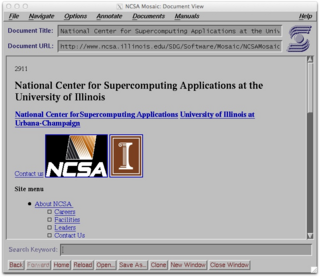
Sir Timothy John Berners-Lee, also known as TimBL, is an English computer scientist best known as the inventor of the World Wide Web, the HTML markup language, the URL system, and HTTP. He is a professorial research fellow at the University of Oxford and a professor emeritus at the Massachusetts Institute of Technology (MIT).

The World Wide Web is an information system that enables content sharing over the Internet through user-friendly ways meant to appeal to users beyond IT specialists and hobbyists. It allows documents and other web resources to be accessed over the Internet according to specific rules of the Hypertext Transfer Protocol (HTTP).

NeXTSTEP is a discontinued object-oriented, multitasking operating system based on the Mach kernel and the UNIX-derived BSD. It was developed by NeXT Computer, founded by Steve Jobs, in the late 1980s and early 1990s and was initially used for its range of proprietary workstation computers such as the NeXTcube. It was later ported to several other computer architectures.

NCSA Mosaic is a discontinued web browser, and one of the first to be widely available. It was instrumental in popularizing the World Wide Web and the general Internet by integrating multimedia such as text and graphics. It was named for its support of multiple Internet protocols, such as Hypertext Transfer Protocol, File Transfer Protocol, Network News Transfer Protocol, and Gopher. Its intuitive interface, reliability, personal computer support, and simple installation all contributed to its popularity within the web. Mosaic is the first browser to display images inline with text instead of in a separate window. It is often described as the first graphical web browser, though it was preceded by WorldWideWeb, the lesser-known Erwise, and ViolaWWW.
NeXT Computer is a workstation computer that was developed, marketed, and sold by NeXT Inc. It was introduced in October 1988 as the company's first and flagship product, at a price of US$6,500, aimed at the higher-education market. It was designed around the Motorola 68030 CPU and 68882 floating-point coprocessor, with a clock speed of 25 MHz. Its NeXTSTEP operating system is based on the Mach microkernel and BSD-derived Unix, with a proprietary GUI using a Display PostScript-based back end. According to the Science Museum Group, "The enclosure consists of a 1-foot die-cast magnesium cube-shaped black case, which led to the machine being informally referred to as 'The Cube.'"

ViolaWWW is a discontinued web browser, the first to support scripting and stylesheets for the World Wide Web (WWW). It was first released in 1991/1992 for Unix and acted as the recommended browser at CERN, where the WWW was invented, but eventually lost its position as most frequently used browser to Mosaic.

Robert Cailliau is a Belgian informatics engineer who proposed the first (pre-www) hypertext system for CERN in 1987 and collaborated with Tim Berners-Lee on the World Wide Web from before it got its name. He designed the historical logo of the WWW, organized the first International World Wide Web Conference at CERN in 1994 and helped transfer Web development from CERN to the global Web consortium in 1995. He is listed as co-author of How the Web Was Born by James Gillies, the first book-length account of the origins of the World Wide Web.

The Line Mode Browser is the second web browser ever created. The browser was the first demonstrated to be portable to several different operating systems. Operated from a simple command-line interface, it could be widely used on many computers and computer terminals throughout the Internet. The browser was developed starting in 1990, and then supported by the World Wide Web Consortium (W3C) as an example and test application for the libwww library.

Interface Builder is a software development application for Apple's macOS operating system. It is part of Xcode, the Apple Developer developer's toolset. Interface Builder allows Cocoa and Carbon developers to create interfaces for applications using a graphical user interface. The resulting interface is stored as a .nib file, short for NeXT Interface Builder, or more recently, as an XML-based .xib file.

The NeXTcube is a high-end workstation computer developed, manufactured, and sold by NeXT from 1990 to 1993. It superseded the original NeXT Computer workstation and is housed in a similar cube-shaped magnesium enclosure, designed by frog design. The workstation runs the NeXTSTEP operating system and was launched with a $7,995 list price.

Libwww is an early World Wide Web software library providing core functions for web browsers, implementing HTML, HTTP, and other technologies. Tim Berners-Lee, at the European Organization for Nuclear Research (CERN), released libwww in late 1992, comprising reusable code from the first browsers.
Nicola Pellow is an English mathematician and information scientist who was one of the nineteen members of the WWW Project at CERN working with Tim Berners-Lee. She joined the project in November 1990, while an undergraduate maths student enrolled on a sandwich course at Leicester Polytechnic. Pellow recalled having little experience with programming languages, "... apart from using a bit of Pascal and FORTRAN as part of my degree course."

The World Wide Web is a global information medium that users can access via computers connected to the Internet. The term is often mistakenly used as a synonym for the Internet, but the Web is a service that operates over the Internet, just as email and Usenet do. The history of the Internet and the history of hypertext date back significantly further than that of the World Wide Web.

Erwise is an early discontinued web browser, and the first that was available for the X Window System.

MacWWW, also known as Samba, is an early minimalist web browser from 1992 meant to run on Macintosh computers. It was the first web browser for the classic Mac OS platform, and the first for any non-Unix operating system. MacWWW tries to emulate the design of WorldWideWeb. Unlike modern browsers it opens each link in a new window only after a double-click. It was a commercial product from CERN and cost 50 European Currency Units
A web browser is a software application for retrieving, presenting and traversing information resources on the World Wide Web. It further provides for the capture or input of information which may be returned to the presenting system, then stored or processed as necessary. The method of accessing a particular page or content is achieved by entering its address, known as a Uniform Resource Identifier or URI. This may be a web page, image, video, or other piece of content. Hyperlinks present in resources enable users easily to navigate their browsers to related resources. A web browser can also be defined as an application software or program designed to enable users to access, retrieve and view documents and other resources on the Internet.

CERN httpd is an early, now discontinued, web server (HTTP) daemon originally developed at CERN from 1990 onwards by Tim Berners-Lee, Ari Luotonen and Henrik Frystyk Nielsen. Implemented in C, it was the first web server software.

The First International Conference on the World-Wide Web was the first-ever conference about the World Wide Web, and the first meeting of what became the International World Wide Web Conference. It was held on May 25 to 27, 1994 in Geneva, Switzerland. The conference had 380 participants, who were accepted out of 800 applicants. It has been referred to as the "Woodstock of the Web".

tkWWW is an early, now discontinued web browser and WYSIWYG HTML editor written by Joseph Wang at MIT as part of Project Athena and the Globewide Network Academy project. The browser was based on the Tcl language and the Tk (toolkit) extension but did not achieve broad user-acceptance or market share, although it was included in many Linux distributions by default. Joseph Wang wanted tkWWW to become a replacement for r r n and to become a "swiss army knife" of networked computing.
ENQUIRE was a software project written in 1980 by Tim Berners-Lee at CERN, which was the predecessor to the World Wide Web. It was a simple hypertext program that had some of the same ideas as the Web and the Semantic Web but was different in several important ways.















